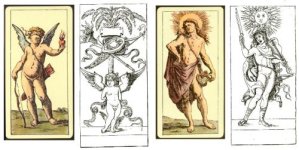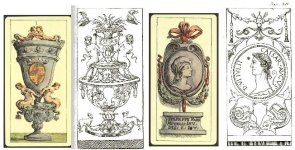DoctorArcanus
http://tarot.selfip.com/picture_library/
131
... It seems much stranger to us to deny the meaning of these leaflets, laughing at those that study a way to explain such meaning.
We know that the interpretation given by the mentioned author can encounter a number of exceptions, and that these mysteries can be explained in different ways. We will refer it briefly, even because it was received with great interest when published on a Cremona almanach in 1814 by Monsignor (a priest) Antonio Dragoni, much learned in pleasant and deep studies. ...
The emblematic cards of tarot being XXI immediately were connected to the Egyptian theory, which was later very dear to Pitagoras, being 3 the perfect number and 7 the mystic number. “That” composed his book including in it all possible perfections and making it as mysterious as possible. He composed it in three classes of images, corresponding to the 3 ages of the World, gold, silver and bronze. Each class is made of 7 divisions ...
The first image had to be 21, the World, first figure of the golden age. In the egg, symbol of creation, is Isis, goddess of time, a the 4 corners the seasons, Eagle springtime, Lion summer, bull autumn, angel winter.
132
By the modern they were mistaken for the evangelists.
XX Judgment a young boy and girl rising from the earth at the voice of Osiris, master of matter, animating them with the fire of creation.
XIX Sun soul of the univere
XVIII Moon, from which the tears of Isis fall. ... The 2 dogs represent another allegory that anybody explain in the same obvious way.
XVII The seven planets, and the Canicola, the most important star; and Isis that when Canicola rises sheds her tears. A symbol of the generation of nature.
XVI castle of Pluto.
XV Tifone AKA the devil. Brother of Isis and Osirisi. .... Closes the golden age and opens the silver age
XIV Temperance ...
XIII This number always unlucky is given to death, that harvests heads.
133
XII Prudence. Who would have said to Mercury that in the end his prudence would have changed in an hanged man? In the Minchiate game and in other Tarots such metamorphosis is not seen.
XI Strength kills the Lion, symbol of deserted earth. Principle of agriculture ....
X Wheel of Forutune. ....
IX The Wise man or Philosopher with light in his hand looking in vain for Justice and Astrea.
VIII Justice
VII Osiris on a triumphal chariot, symbol of wars in the bronze age.
VI Marriage. Love blends honour and truth. The necessity of bindings and law was necessary in an age in which freedom was everywhere. Concubito prohibere vago, dare jura maritis (to forbid the easy intercourse, to give laws to the husbands)
V Jerofante, great priest, Pope. With triple Tau, sign per excellence. Necessity to create a priestly hierarchy.
IV King
III Queen
II Great Priestess of Papesse. In ancient times priests could marry. So it was given this incorrect name. She was also said the pride of the powerful, since she was sometime replaced by a Juno with peacocks. And you also see Jove instead of the Pope.
134
I The player making wonders with his stick. He is also said Pagad or Bagat, that is arbiter of fortune. In eastern languages Pag is chief and Gad fortune. ...
0 Zero, Fool, Matto, without brain. This numberless card completes the sacred alphabet of That. Corresponds to Tan which means conclusion and perfection. ....
This book was also made more mysterious in ancient times ... It was made appropriate for the division in four classes: nobles or soldiers, priests, peasants, merchants, and artists found their place in the book of That ... so the mystic 7 had the first place in the book, and his meaningful images where 10 times 7 that is 77. The most mysterious of numbers, to which adding the Fool, ..., the number of Tarot is completed as it is universally known: 78 cards. ...
The Sword signifies the class of nobles and solders, kingly strength, victory ....
131
... It seems much stranger to us to deny the meaning of these leaflets, laughing at those that study a way to explain such meaning.
We know that the interpretation given by the mentioned author can encounter a number of exceptions, and that these mysteries can be explained in different ways. We will refer it briefly, even because it was received with great interest when published on a Cremona almanach in 1814 by Monsignor (a priest) Antonio Dragoni, much learned in pleasant and deep studies. ...
The emblematic cards of tarot being XXI immediately were connected to the Egyptian theory, which was later very dear to Pitagoras, being 3 the perfect number and 7 the mystic number. “That” composed his book including in it all possible perfections and making it as mysterious as possible. He composed it in three classes of images, corresponding to the 3 ages of the World, gold, silver and bronze. Each class is made of 7 divisions ...
The first image had to be 21, the World, first figure of the golden age. In the egg, symbol of creation, is Isis, goddess of time, a the 4 corners the seasons, Eagle springtime, Lion summer, bull autumn, angel winter.
132
By the modern they were mistaken for the evangelists.
XX Judgment a young boy and girl rising from the earth at the voice of Osiris, master of matter, animating them with the fire of creation.
XIX Sun soul of the univere
XVIII Moon, from which the tears of Isis fall. ... The 2 dogs represent another allegory that anybody explain in the same obvious way.
XVII The seven planets, and the Canicola, the most important star; and Isis that when Canicola rises sheds her tears. A symbol of the generation of nature.
XVI castle of Pluto.
XV Tifone AKA the devil. Brother of Isis and Osirisi. .... Closes the golden age and opens the silver age
XIV Temperance ...
XIII This number always unlucky is given to death, that harvests heads.
133
XII Prudence. Who would have said to Mercury that in the end his prudence would have changed in an hanged man? In the Minchiate game and in other Tarots such metamorphosis is not seen.
XI Strength kills the Lion, symbol of deserted earth. Principle of agriculture ....
X Wheel of Forutune. ....
IX The Wise man or Philosopher with light in his hand looking in vain for Justice and Astrea.
VIII Justice
VII Osiris on a triumphal chariot, symbol of wars in the bronze age.
VI Marriage. Love blends honour and truth. The necessity of bindings and law was necessary in an age in which freedom was everywhere. Concubito prohibere vago, dare jura maritis (to forbid the easy intercourse, to give laws to the husbands)
V Jerofante, great priest, Pope. With triple Tau, sign per excellence. Necessity to create a priestly hierarchy.
IV King
III Queen
II Great Priestess of Papesse. In ancient times priests could marry. So it was given this incorrect name. She was also said the pride of the powerful, since she was sometime replaced by a Juno with peacocks. And you also see Jove instead of the Pope.
134
I The player making wonders with his stick. He is also said Pagad or Bagat, that is arbiter of fortune. In eastern languages Pag is chief and Gad fortune. ...
0 Zero, Fool, Matto, without brain. This numberless card completes the sacred alphabet of That. Corresponds to Tan which means conclusion and perfection. ....
This book was also made more mysterious in ancient times ... It was made appropriate for the division in four classes: nobles or soldiers, priests, peasants, merchants, and artists found their place in the book of That ... so the mystic 7 had the first place in the book, and his meaningful images where 10 times 7 that is 77. The most mysterious of numbers, to which adding the Fool, ..., the number of Tarot is completed as it is universally known: 78 cards. ...
The Sword signifies the class of nobles and solders, kingly strength, victory ....



